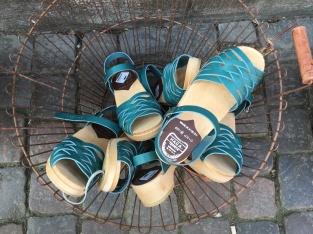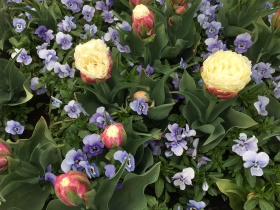Two Old Town Centers in Sweden
#2 in a series on tour in Sweden in May 2017

The typical red wooden houses at a lake
In Sweden, many houses are still made of wood and are seen everywhere in the landscape. Homes in different colours often with white framing. The gardens have lawns and a few bushes or trees. In Denmark, we have a tradition of hiding our brick houses behind hedges.
In the 1960s many of the Swedish towns were renewed and they look-alike with boring concrete departments and shopping centres.
Thankfully there are towns and cities where the original wooden and stone houses are kept, and people gather to stroll through the pretty cobblestone streets. One of these places is Haga in central Gothenburg. The city is placed on the east coast of Sweden not far from Denmark. Haga was the first suburb of Gothenburg. The area is from the mid 17th century and later got a bad reputation. It was nearly demolished in the 1960s.
I haven’t photoed the streets of Haga, but the area looks similar to the roads of Eksjoe further down this post. Raul Wallenberg was a real hero. As a young Swedish diplomat in Budapest during the WWII, he saved thousands of Jews giving them a false passport even at the cattle wagons. He was taken by the Soviets, and he disappeared in their prisons. The picture is from 2010. On this trip, it was damaged by graffiti. More on this memorial here where the Haga houses can be seen in the background.
A funding Haga it and It was renovated in the 1980s. Today it’s an attractive district with shops and cafes and restaurants. The Haga Bath, a bathhouse in Art Nouveau Style, is also beautifully renovated but very expensive to enter.
A few pictures of the architecture in Gothenburg
A ferry from Denmark takes us to coastal Gothenburg in 3 hours. It’s the second largest city in Sweden. The city and nature are so different from our country. Houses are more impressive, and the area is hilly and rocky. I have been there many times as I run a big race every May, but I still haven’t a full view over the parts as the trams take you in and out in different directions avoiding the steep rocky hills. The old city has fortifications and water canals which cut up the streets and make me lose track of destinations. Dutch experts built the town on wet areas as Manhattan and Jakarta. You can read about the city, and it’s history here.
In another central part of the city is a park called “The Garden Association” “Trädgårdsföreningen”. We go there every time as tulips and wild pansies are arranged in colourful flowerbeds. A vast greenhouse as a model of the famous Crystal Palace in London and lovely modern playground and cafes in old wooden houses are spread around in the park.
The other place I would like to mention is the so-called Wooden Town of Eksjoe. The town is situated in the area called Smaaland 223 km east of Gothenburg. See the first post in the series. The homepage has some excellent photos. The town origins from the early Middle-ages.
Pictures from this trip in May 2017 in Eksjoe
The old wooden houses in the inner town of Eksjoe in Smaaland. They are lucky that it didn’t get the “Renovation Treatment” in the 1960s.
Categories: Sweden, Travelling


























Would like to take one of those boats out.
LikeLiked by 1 person
Wonderful to see photos of vintage towns in your part of the words, Maria – my favorites in America as well (tho’ very different). My taste has never run to “modern.”
Love the photos of the gardens, but since my little Tink is not welcome, I doubt I would enjoy visiting nearly as much as if he were allowed to be by my side – on a leash, of course. Since Tinker is my “baby,” I avoid places he is not allowed, reacting as I might to a “NO KIDS” sign had I children. ::sigh::
I ALWAYS carry clean-up bags, on a roll inside a small plastic bone attached to my keys, and am careful where I allow him to stop to sprinkle – but I suppose that, as usual, the few self-focused and highly inconsiderate people ruin things for the many who are not.
In case you were not already aware, btw, Bernadette’s son died — two days ago, I believe. There is a short post on HaddensMusings where some of us from the Salon are leaving condolences.
xx,
mgh
(Madelyn Griffith-Haynie – ADDandSoMuchMORE dot com)
ADD/EFD Coach Training Field founder; ADD Coaching co-founder
“It takes a village to educate a world!”
LikeLiked by 2 people
Thank you Madelyn for your lovely response. Yes I read her post on her son. It’s so sad. I also tried to write her something.
I hope she will resume writing on her blog as I find it so helpful even in such a period of grieving or at least after some time.
I included the sign : no dogs because it was so unusual. Have never seen it before in other parks or botanic gardens in Sweden.
I also
LikeLiked by 1 person
I’m happy to hear that dogs are not universally banned from parks in Scandinavia. Tinker is thrilled as well, though I doubt it will affect his life – lol. I’m unlikely to chance subjecting him to quarantine requirements, so I’d probably leave him with a friend were I to be lucky enough to visit.
xx,
mgh
LikeLike
You know you have a permanent invitation at my place with or without Tinker
LikeLiked by 1 person
What a lovely invitation. I would love some day to be in a position to take you up on it!
My current apartment is not one that is especially welcoming for guests – but I hope this does not turn out to be “my final resting place” and would certainly love to return your kind invitation when I am in a better situation.
xx,
mgh
LikeLike
I apologise for the abrupt sentence. I have forgotten what I wanted to say!!! But in Sweden they have many (ridiculous) signs like it’s parents talking to small kids. The Swedish people are more authoritarian than we in Denmark. If something is forbidden then it’s respected. In Denmark we think more “free” like this can’t count for me. I have not mentioned in my posts but they have grave problems with immigrants spread all over. The Swedes are told to welcome them and they are being taken advantage of to say the least
LikeLike
More lovely history and pictures, Maria. This is a great series of posts 😊
LikeLiked by 1 person
I am so glad to hear that from you. It’s possible to create posts out of photos and nearly any situation or small travel
LikeLiked by 1 person
I love the wooden houses of different colors. My favorite is blue. What an interesting and lovely place. Thank you for taking me for a tour.
LikeLiked by 2 people
Bless you what an encouragement
LikeLiked by 1 person
I am glad to see more of Sweden. A Swedish friend tells me of life there, but your photos always show that you have the eye of an artist. On a trip to Quebec City we also saw houses of many colors and also red roofs. These vivid colors must add cheer during the long winters.
LikeLiked by 2 people
So nice to hear that Paula
LikeLike
What a delight to see these wonderful impressions from beautiful Sweden! ❤ 🇸🇪
LikeLike
thank you very much Dina. We hear so much about the problems in Sweden but there are still these innocent spots to be seen
LikeLiked by 1 person